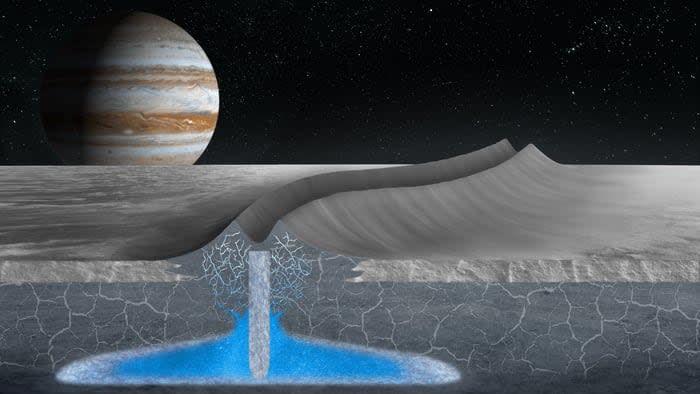The Chances of Finding Alien Life on Jupiter’s Moon Europa Just Shot Way Up
- Oops!Something went wrong.Please try again later.
Forget Mars—Jupiter’s moon Europa is one of the most promising worlds in the solar system to look for alien life, in large part because it boasts a huge liquid ocean sitting below a sheet of ice. Although Europa is just one-fourth the diameter of Earth, its ocean may have twice as much water as our planet’s oceans combined. And where there is water, there is the chance for life as we know it to settle down.
But actually discovering whatever alien life might live on Europa will be an extremely tough challenge. The moon’s icy shell is thought to be 10 to 15 miles thick. The furthest humans have ever dug into Earth is 7.67 miles.
However, it might not be as daunting as we think. A new study published in Nature Communications on Tuesday reveals that the icy shell itself might be much more porous than previously thought. In fact, the ice might be home to multiple pockets of water that could support life as well.
Why NASA is Obsessed With Europa, Jupiter’s Watery Moon
The key to these new findings? Greenland. New data collected with ice-penetrating radar shows the formation of “double ridge” features in the Greenland ice sheet—features that are present on Europa as well. The researchers behind the new paper believe that the mechanism for how these double ridges formed in Greenland ought to apply to Europa—which suggests that there is more liquid water on the Jovian moon than we could ever have imagined.
“It was really a bit of serendipity,” Riley Culberg, an electrical engineer pursuing a PhD at Stanford University who led the new study, told The Daily Beast. “One of my colleagues on this paper, who is a planetary scientist, was giving a presentation on the big open questions in Europa science and showed a picture of these double ridges on the surface. It struck me that I had seen a similar looking feature in my own data from Earth while working on a totally different project related to climate change impacts on the Greenland ice sheet.”
Culberg and his colleagues went back to the Europa data, and found that double ridges on the Jovian moon (first observed in the 1990s by NASA’s Galileo mission) exhibit a peculiar kind of ratio between the height of the ridges and the distance between the two peaks. After accounting for the difference in gravity between Earth and Europa, the team realized the Greenland features had a pretty similar ratio as well, which meant the double ridges seemed to form similarly in both places.

Artist’s conception shows how double ridges on the surface of Jupiter’s moon Europa may form over shallow, refreezing water pockets within the ice shell.
We know that the double ridges form in Greenland when ice fractures around pockets of pressurized liquid water that was refreezing inside the ice sheet, prompting two peaks to rise in a specific shape. These pockets of water are shallow and help make the ice sheet more porous.
The researchers believe the same mechanism accounts for the double ridges on Europa—meaning the icy shell is dynamic, permeable, and perhaps rife with shallow bodies of liquid water.
“If Europa’s double ridges also form in this way, it suggests that shallow water pockets must have been, or maybe still are, extremely common in the ice shell,” said Culberg. “Double ridges are by far the most common surface that we see in imagery from Europa, so if they form over water, it would really have to be everywhere in the ice shell.” That means the opportunities for life to evolve on the Jovian moon are much more common.
Culberg cautioned that we won’t be able to confirm any of this until we’ve had a chance to actually study Europa directly. That will likely occur in the next decade: NASA is planning to launch an orbiting probe called Europa Clipper in October 2024, and it should arrive on Europa in April 2030. It will be armed with an ice-penetrating radar that will be critical at telling us more about Europa’s icy shell—and should help uncover whether Europa really is our solar system’s best bet for supporting life.
Got a tip? Send it to The Daily Beast here
Get the Daily Beast's biggest scoops and scandals delivered right to your inbox. Sign up now.
Stay informed and gain unlimited access to the Daily Beast's unmatched reporting. Subscribe now.

